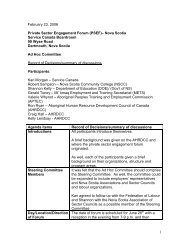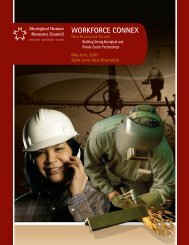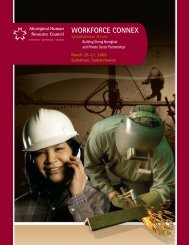Workforce connex - Aboriginal Human Resource Council
Workforce connex - Aboriginal Human Resource Council
Workforce connex - Aboriginal Human Resource Council
You also want an ePaper? Increase the reach of your titles
YUMPU automatically turns print PDFs into web optimized ePapers that Google loves.
—— Often not related to the employer, all about taking opportunitiesoffering higher pay or better career advancement.• Brandon Regional Health Authority – challenge was to convince the <strong>Aboriginal</strong>community that they are in fact an <strong>Aboriginal</strong> friendly organization.—— Have a person “hitting the pavement” to build relationships—— Has 16 partners—— Good at recruitment, not retention. Trying to find out why?—— Needing to be more flexible –social support systems(i.e., single mother’s child is sick – she has nophone to call in to work, misses a day)• <strong>Aboriginal</strong> people do not want to work somewhere whereit is not representative of the population.••Internal work is as important of external work.There is favoritism in the workforce, bias, racism, stereotyping.• Ignorance is different than stereotyping – sometimesit is not a case of racism but of ignorance.• Fear in the federal government of <strong>Aboriginal</strong> politics – donot know how to work with <strong>Aboriginal</strong> people.•Fear of what to say among managers.• Need to judge employees (who are asking to make moremoney) based on their skills and accomplishments.• Sometimes there are subtle or “innocent” discriminations – whenit is there, you cannot ignore it, you must deal with it.••Interviews are intimidating; should be dealt with as a conversation.Be aware of home life to be flexible to realities of their life.• <strong>Aboriginal</strong> training done in groups – Is this the rightway? Are we setting them up for failure?••Need allowance for <strong>Aboriginal</strong> people to tour workplaces to see how it works.Peer support groups are useful.• <strong>Aboriginal</strong> awareness training not always mandatory – often requiressupervisor approval – multiple barriers to implement this.• Important to feel accepted and connected – difficult todo in a workplace with few <strong>Aboriginal</strong> people.• Cross-cultural communication – <strong>Aboriginal</strong> people needto learn about the workplace culture and employers andmanagers need to learn about <strong>Aboriginal</strong> culture.• Important not to implement affirmative actionprograms which only create resentment.•••Representative workforce programs are based on qualifications.“Token Indians” and quotas are not good things.What do you need to know about AHRDA’s to help employers?—— AHRDAs significantly helped Standard Aero – bridgingthe gap in understanding between two worlds—— Hire people for jobs based on their qualifications;must not lower expectations.• AHRDA – was good for them to go through mock applicationprocesses of the federal government; allows them tobetter understand how to help their clients.••••Education levels of clients?—— Often high level or lower—— Most communities require students to leavecommunity for grade 9 or higher.Cultural expectation is to take time off in event of death.Employer cost vs. cultural necessity—— Solution: lots of part time employees.People are scared to leave their community.Overcoming BarriersProvide advice to AHRDAs about how to overcomebarriers to positive engagement with business.••••••••Sit down with employer regarding paperwork.Accountability.Keep track of the employee.Bridge employers lack of knowledge of training offered by AHRDAs.Provide financial support.Discuss expectations at front end (i.e., time off, problems)—— This is where the trainers and trainees come in.AHRDAs share their expectations and companies share their expectations.Contracts.• Communities need to make changes (i.e., lookat effect if community shut downs).• Operating policies and collective agreements – beblunt to leadership regarding effects.••Seek equity rather than assimilation.Focus on reality vs. respect people.• Ensure job description fits with what person will actually be doingand bona fide requirements (i.e., must have grade 12).••Use programs available; contact “us”; be proactive.Be flexibile.• Creating partnerships between AHRDAs and businesses.Elements of a meaningful partnership:14<strong>Aboriginal</strong> <strong>Human</strong> <strong>Resource</strong> <strong>Council</strong>Manitoba <strong>Workforce</strong> Connex Report









